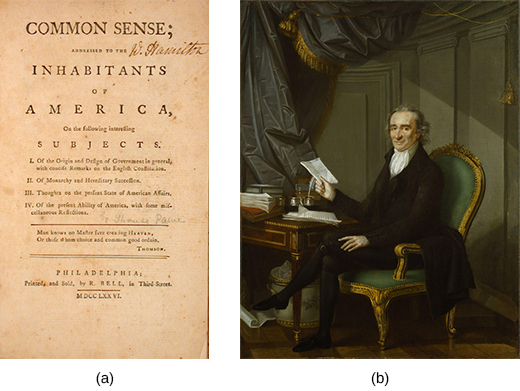| << Chapter < Page | Chapter >> Page > |
With the events of 1775 fresh in their minds, many colonists reached the conclusion in 1776 that the time had come to secede from the Empire and declare independence. Over the past ten years, these colonists had argued that they deserved the same rights as Englishmen enjoyed in Great Britain, only to find themselves relegated to an intolerable subservient status in the Empire. The groundswell of support for their cause of independence in 1776 also owed much to the appearance of an anonymous pamphlet, first published in January 1776, entitled Common Sense . Thomas Paine, who had emigrated from England to Philadelphia in 1774, was the author. Arguably the most radical pamphlet of the revolutionary era, Common Sense made a powerful argument for independence.
Paine’s pamphlet rejected the monarchy, calling King George III a “royal brute” and questioning the right of an island (England) to rule over America. In this way, Paine helped to channel colonial discontent toward the king himself and not, as had been the case, toward the British Parliament—a bold move that signaled the desire to create a new political order disavowing monarchy entirely. He argued for the creation of an American republic, a state without a king, and extolled the blessings of republicanism , a political philosophy that held that elected representatives, not a hereditary monarch, should govern states. The vision of an American republic put forward by Paine included the idea of popular sovereignty : citizens in the republic would determine who would represent them, and decide other issues, on the basis of majority rule. Republicanism also served as a social philosophy guiding the conduct of the Patriots in their struggle against the British Empire. It demanded adherence to a code of virtue, placing the public good and community above narrow self-interest.
Paine wrote Common Sense ( [link] ) in simple, direct language aimed at ordinary people, not just the learned elite. The pamphlet proved immensely popular and was soon available in all thirteen colonies , where it helped convince many to reject monarchy and the British Empire in favor of independence and a republican form of government.

In the summer of 1776, the Continental Congress met in Philadelphia and agreed to sever ties with Great Britain. Virginian Thomas Jefferson and John Adams of Massachusetts, with the support of the Congress, articulated the justification for liberty in the Declaration of Independence ( [link] ). The Declaration, written primarily by Jefferson, included a long list of grievances against King George III and laid out the foundation of American government as a republic in which the consent of the governed would be of paramount importance.

Notification Switch
Would you like to follow the 'U.s. history' conversation and receive update notifications?